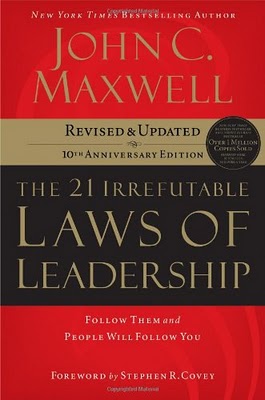According to Dr. John Maxwell, everything rises and falls on leadership. Leadership is key to your success. In his book, The 21 Irrefutable Laws of Leadership: Follow Them and People Will Follow You, Dr. Maxwell explains each of these laws (not just principles) and how to apply them to your life.
The 21 Irrefutable Laws of Leadership: Follow Them and People Will Follow You
 Everything rises and falls on leadership! – Dr. John Maxwell
Everything rises and falls on leadership! – Dr. John Maxwell
Leadership is key to your success.
Where do most people go to learn leadership?
According to leadership expert Dr. John Maxwell, “The answer to that question today is that they search many places. Some examine the world of politics. Other seek models in the entertainment industry. Many look to the world of business. Most people seem to look to successful CEOs, management consultants, and theoriticians with Ph.D.s to learn about leadership”
“But the trust is, the best source of leadership teaching today is the same as it has been for thousands of years. If you want to learn leadership, go to the greatest Book on leadership ever written – the Bible.“
“The most critical problem facing the church today is the leadership vacuum that grew during the Twentieth Century. He says “the American church is dying due to lack of strong leadership.”
Dr. Maxwell further asserts that “leadership is influence, nothing more, nothing less.”
Meditate Inc. Magazine voted John Maxwell as the #1 leadership and management expert in the world!
May Dr. Maxwell’s teaching bless you as it has blessed me.
Intro – 21 Irrefutable Laws of Leadership
Executive Summary: “The 21 Irrefutable Laws of Leadership”
Source: Perspective – Resources for Bible Teachers
Not so much a book review, but an ‘Executive Summary’, a condensing of key ideas… Leadership consultant and former pastor John Maxwell offers twenty one “laws” distilled from his experience as a self-confessed “expert leader”..
Leadership consultant and former pastor John Maxwell offers twenty one “laws” distilled from his experience as a self-confessed “expert leader.”
- The Law of the Lid
Your leadership is like a lid or a ceiling on your organization. Your church or business will not rise beyond the level your leadership allows. That’s why when a corporation or team needs to be fixed, they fire the leader.
- The Law of Influence
Leadership is simply about influencing people. Nothing more, nothing less. The true test of a leader is to ask him to create positive change in an organisation. If you cannot create change, you cannot lead. Being a leader is not about being first, or being an entrepreneur, or being the most knowledgeable, or being a manager. Being a leader is not just holding a leadership position. (“It’s not the position that makes a leader, but the leader who makes a position.”) Positional leadership especially does not work in volunteer organisations. The very essence of all power to influence lies in getting the other person to participate. “He who thinks he leads , but has no followers, is only taking a walk.”
- The Law of Process
Leadership is learned over time. And it can be learned. People skills, emotional strength, vision, momentum, and timing are all areas that can and should be learned. Leaders are always learners.
- The Law of Navigation.
Anyone can steer the ship, but it takes a leader to chart the course. Vision is defined as the ability to see the whole trip before leaving the dock. A leader will also see obstacles before others do. A leader sees more, sees farther, and sees before others. A navigator (leader) listens – he finds out about grassroots level reactions. Navigators balance optimism with realism. Preparation is the key to good navigation. “It’s not the size of the project, it’s the size of the leader that counts.”
- The Law of E.F. Hutton
Hutton was America’s most influential stock market analyst. When he spoke, everyone listened. When real leaders speak, people automatically listen. Conversely, in any group or church, you can identify the real leaders by looking for those who people listen to. According to Margaret Thatcher, “being in power is like being a lady – if you have to tell people you are, you aren’t.” (p45) Tips for a Positional leader – like a newly appointed minister – who wants to become a REAL leader… look for the existing real leaders and work to have influence there. Factors involved in being accepted as a new real leader include character, building key relationships, information, intuition, experience, past success. and ability.
- The Law of Solid Ground
Trust is the foundation for all effective leadership. When it comes to leadership, there are no shortcuts. Building trust requires competence, connection and character.
- The Law of Respect
People naturally follow people stronger than themselves. Even natural leaders tend to fall in behind those who they sense have a higher “leadership quotient” than themselves.
- The Law of Intuition
Leaders evaluate everything with a Leadership bias. Leaders see trends, resources and problems, and can read people.
- The Law of Magnetism
Leaders attract people like themselves. Who you are is who you attract. (Mmmm… I thought like poles were meant to repel!) Handy hint: “Staff” your weaknesses. If you only attract followers, your organisation will be weak. Work to attract leaders rather than followers if you want to build a truly strong organisation.
- The Law of Connection
You must touch the heart before you ask people to follow. Communicate on the level of emotion first to make a personal connection.
- The Law of the Inner Circle
A leader’s potential is determined by those closest to him. “The leader finds greatness in the group, and helps the members find it in themselves.” (p113)
- The Law of Empowerment
Only secure leaders give power to others. Mark Twain said, “Great things can happen when you don’t care who gets the credit.” (p127). Another point to ponder… “Great leaders gain authority by giving it away.”
- The Law of Reproduction
It takes a leader to raise up a leader. Followers can’t do it, and neither can institutional programs “It takes one to know one, to show one, to grow one.” The potential of an organisation depends on the growth of its leadership.
- The Law of Buy-In
People buy in to the leader first, then the vision. If they don’t like the leader but like the vision, they get a new leader. If they don’t like the leader or the vision, they get a new leader. If they don’t like the vison but like the leader, they get a new vision.
- The Law of Victory
Leaders find a way for the team to win. “You can’t win WITHOUT good athletes, but you CAN lose with them.” p162). Unity of vision, diversity of skills plus a leader are needed for a win.
- The Law of Momentum
You can’t steer a ship that isn’t moving forward. It takes a leader to create forward motion.
- The Law of Priorities
Activity is not necessarily accomplishment. We need to learn the difference. “A leader is the one who climbs the tallest tree, surveys the entire situation, and yells “Wrong Jungle!”” (p176) If you are a leader, you must learn the three “Rs”… a) what’s Required b) what gives the greatest Return c) what brings the greatest Reward.
- The Law of Sacrifice
A leader must give up to go up. Successful leaders must maintain an attitude of sacrifice to turn around an organisation. One sacrifice seldom brings success. As he worked to turn around the Chrysler Corporation, Lee Iacocca slashed his own salary to $1 per year.”When you become a leader, you lose the right to think about yourself.”
- The Law of Timing
When to lead is as important as what to do and where to go. Only the right action at the right time will bring success.
- The Law of Explosive Growth
To add growth, lead followers. To multiply growth, lead leaders. “It is my job to build the people who are going to build the company.”
- The Law of Legacy
A leader’s lasting value is measured by succession. “Leadership is the one thing you can’t delegate. You either exercise it – or abdicate it.”
Two new laws in 10th edition book
- The Law of Addition: We add value to people by serving them!
- The Law of the Picture: People do what people see! It’s all about example. The greatest leadership is by example.
More Executive Summaries for The 21 Irrefutable Laws of Leadership
Observations about these 21 Laws
- These laws can be learned.
- They stand alone. They are independent, but do interlock (inter-relate). For example, you don’t have to learn Law #1 to learn Law #2.
- These laws carry consequences. If you obey them, you will receive good stuff. If you don’t, you will be in trouble.
- These laws are the foundation of leadership. You build your leadership on these laws.
Blessings to learn and apply these Irrefutable Laws of Leadership!



Recent Comments